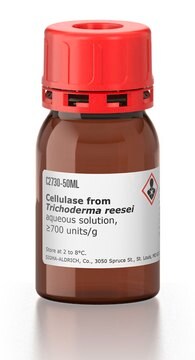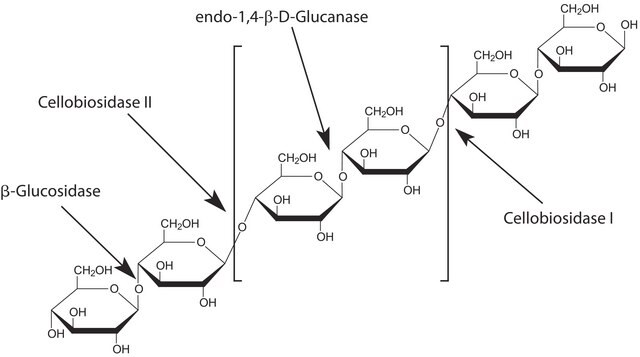C8546
Cellulase from Trichoderma reesei ATCC 26921
lyophilized powder, ≥1 unit/mg solid
Synonym(s):
1,4-(1,3:1,4)-β-D-Glucan 4-glucano-hydrolase
Sign Into View Organizational & Contract Pricing
All Photos(6)
About This Item
Recommended Products
form
lyophilized powder
Quality Level
specific activity
≥1 unit/mg solid
greener alternative product characteristics
Waste Prevention
Design for Energy Efficiency
Learn more about the Principles of Green Chemistry.
sustainability
Greener Alternative Product
solubility
deionized water: soluble 5.0 mg/mL (Sterile; In the presence of 0.15% polyhexamethylene biguanide (PHMB).)
greener alternative category
storage temp.
2-8°C
General description
We are committed to bringing you Greener Alternative Products, which adhere to one or more of The 12 Principles of Greener Chemistry. This product has been enhanced for energy efficiency and waste prevention when used in cellulosic ethanol research. For more information see the article in biofiles and Enzymes for Alternative Energy Research.
Application
Cellulase from Sigma has been used to degrade cello-oligosaccharides into glucose; to study the biodegradability of bioabsorbable bacterial cellulose (BBC) material.
Cellulase from Trichoderma reesei has been used in a study to assess the differential regulation of the cellulase transcription factors XYR1, ACE2, and ACE. Cellulase from Trichoderma reesei has also been used in a study to investigate the liquefaction of hydrothermally pretreated wheat straw at high-solids content.
Biochem/physiol Actions
Cellulases are enzymes that hydrolyze cellulose to glucose. Cellulase is used to study the development of occupational asthma in the detergent, pharmaceutical, baking, and enzyme production industries. Cellulase is added to detergents to improve cleansing properties. It is also applied in the biodegradation of paper products such as foolscap paper, filter paper, newspaper and office paper as well as microcrystalline cellulose.
Unit Definition
One unit will liberate 1.0 μmole of glucose from cellulose in one hr at pH 5.0 at 37 °C (2 hr incubation time).
Preparation Note
Dissolves in sterile deionized (DI) water in the presence of 0.15% polyhexamethylene biguanide (PHMB) at 5 mg/mL concentration.
Other Notes
View more information on enzymes for complex carbohydrate analysis at www.sigma-aldrich.com/enzymeexplorer
substrate
Product No.
Description
Pricing
Signal Word
Danger
Hazard Statements
Precautionary Statements
Hazard Classifications
Resp. Sens. 1
Storage Class Code
11 - Combustible Solids
WGK
WGK 1
Flash Point(F)
Not applicable
Flash Point(C)
Not applicable
Personal Protective Equipment
dust mask type N95 (US), Eyeshields, Gloves
Choose from one of the most recent versions:
Already Own This Product?
Find documentation for the products that you have recently purchased in the Document Library.
Customers Also Viewed
Nóra Szijártó et al.
Bioresource technology, 102(2), 1968-1974 (2010-10-05)
Enzymatic liquefaction was studied by measuring continuously the flowability change of high-solids lignocellulose substrates using a real time viscometric method. Hydrolysis experiments of hydrothermally pretreated wheat straw were carried out with purified enzymes from Trichoderma reesei; Cel7A, Cel6A, Cel7B, Cel5A
J P H van Wyk et al.
Bioresource technology, 86(1), 21-23 (2002-11-08)
Environmental issues such as the depletion of non-renewable energy resources and pollution are topical. The extent of solid waste production is of global concern and development of its bioenergy potential can combine issues such as pollution control and bioproduct development
Thomas Portnoy et al.
Eukaryotic cell, 10(2), 262-271 (2010-12-21)
Due to its capacity to produce large amounts of cellulases, Trichoderma reesei is increasingly being investigated for second-generation biofuel production from lignocellulosic biomass. The induction mechanisms of T. reesei cellulases have been described recently, but the regulation of the genes
Ming-Li Yong et al.
Microscopy research and technique, 79(9), 838-844 (2016-07-01)
Rice false smut, caused by the fungal pathogen Villosiclava virens, is one of the most important rice diseases in the world. Previous studies reported that the pathogen has less number of cell wall-degraded genes and attacks dominantly rice stamen filaments
Evgenij Lyagin et al.
Biotechnology journal, 5(8), 813-821 (2010-07-30)
The screening of catalysts, substrates or conditions in the early stages of bioprocess development requires an enormous number of experiments and is a tedious, expensive and time-consuming task. Currently available screening systems can only be operated in batch or fed-batch
Our team of scientists has experience in all areas of research including Life Science, Material Science, Chemical Synthesis, Chromatography, Analytical and many others.
Contact Technical Service







